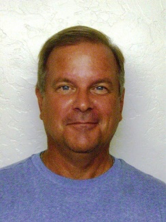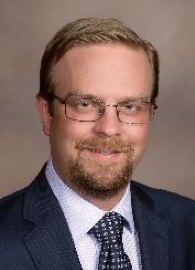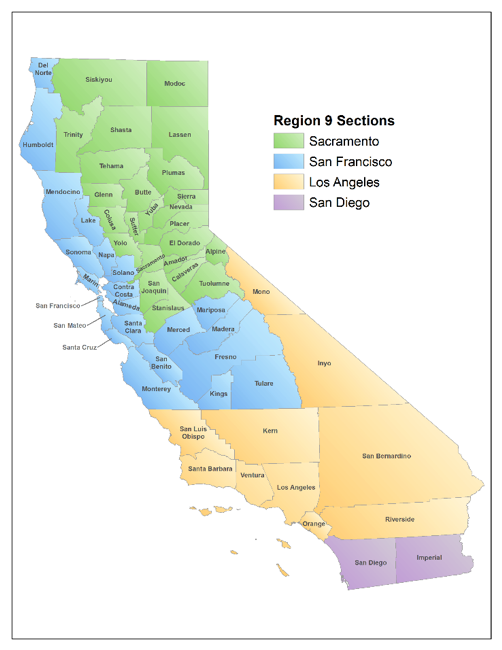July 2020 – Region 9 Reports
REGION 9 REPORTS – JULY 2020 NEWSLETTER
Disaster Preparedness Update
by Doug Taylor, P.E., M.ASCE
Chair, ASCE Region 9 Disaster Preparedness Committee

What do COVID-19 and Earthquakes Have in Common?
You can hardly watch an hour of television these days without some mention of the heroes (doctors, nurses… even grocery store workers!) who are working to help us all despite risking their health and even their lives. Well guess what… someday California is going to have another big earthquake and YOU are going to be the hero of the day. That is IF you get trained and certified as a Safety Assessment Program (SAP) Evaluator. Hundreds of licensed civil engineers will be needed to rapidly assess homes and commercial buildings so people and businesses can get back to normal life (sound familiar?). If you think “stay at home” orders make life difficult, imagine the hardship when families can’t go back into their homes and have to live in FEMA shelters until their home is inspected (rapidly assessed)!
It’s SO easy to get trained and certified… once the COVID-19 orders to stay home are lifted, that is. Right now, there are no training sessions due to the “stay at home” orders.
But wait! Cal OES just approved online training so you can participate in a webinar to get certified. SAP Trainers can now set up these webinars and give them in one, 6-hour session, or two, 3-hour sessions or… you get the idea. Following the webinar training, Cal OES will send an exam to participants. Once they have completed the exam, they will scan and email the exam back to Cal OES who will grade and process the certificates. The exam is open book so the odds of passing are pretty good (but you have to pass with a 70% score or better, and no re-takes allowed).
Now I’m going to make this really easy for you. I’m setting up a webinar for Saturday, June 20th from 9 am to 3:30 pm (a half hour for lunch) and you can be one of the 30 people to register. Best of all… IT’S FREE. And you get to take it from the comfort of wherever. Just email me at dtaylor@outbackmaterials.com and give me your full name and cell phone number. I’m only registering licensed PEs for this session (no EITs for now).
I hope you’ll take advantage of this opportunity. Then you’ll be ready to help when people who don’t have your skills will need you desperately.

Region 9 Water Committee Hot Topics –
Water and Wastewater in the Time of Covid-19
by Xavier Irias, P.E., M. ASCE
Chair, ASCE Region 9 Water and Environment Committee

It’s simply not possible to write this year’s Water article without talking about the coronavirus pandemic which continues to impact us. February seems a distant memory: a time when we all commuted to work, when grocery stores were fully stocked, when the news was about something besides a virus and its impacts on society, when we weren’t all wearing masks.
While relatively few of us have been sickened by the virus, many of us know somebody’s who’s been sick and a few of us have lost a loved one to the virus. All of us have been greatly affected in our personal and professional lives by the many changes brought about by the shelter-in-place mandates.
These difficult times have a way of reminding people which things are really important; Health care, Food and Water. In fact, while water is essential in its own right, it’s also essential to the function of all 15 of the other “critical sectors”. Without water, you can’t produce food, power, or fuel. And you can’t run a hospital. Note that when we say water, we mean wastewater too; what good is a truckload of toilet paper unless there’s a way to flush?
In accordance with their essential nature, water and wastewater utilities throughout the State have remained open during the pandemic even though many other activities have been shut down to control the virus’ spread. While some water sector workers can telecommute to a degree, the basic work of running treatment plants and repairing pipes requires a physical presence. Those front-line workers in the water and wastewater sectors are fulfilling a role every bit as important as that of medical workers, i.e., keeping the basic underpinnings of modern society intact. For some water sector workers, this means coming to work more or less as usual; for others, it requires juggling home-school duties or elder care; and for still others, it’s a more drastic change in lifestyle. For example, the operators of the San Diego County Carlsbad desalination plant are living in rented RV’s at the plant, seeing their families only by web chat; this isolation ensures that the plant can stay running and keep water flowing to customers.
So far, the complex engine that is our economy continues to run, albeit with a sputter. And thus, with the exception of a brief hiccup in carbon dioxide availability, the basic staples needed to keep water flowing have continued: fuel, treatment chemicals, electrical power, financial services. However, as the pandemic continues, there is growing concern about the economic impact of the pandemic. In a recent AWWA survey, most water utilities reported either experiencing a financial pinch or expecting to do so as a result of the pandemic. These survey results came as no surprise, given the hardships being endured by individuals and businesses that will continue to ripple through the economy. In California, water (and power) utilities have generally announced that they are suspending disconnections for failure to pay; while this is an appropriate step, it will not be without impact.
Even before the pandemic, affordability of water and wastewater service was a top-tier issue facing the industry, as rate pressure caused by aging infrastructure, combined with other economic pressures such as the high cost of housing, posed a huge challenge to industry professionals tasked with somehow providing safe, reliable service while controlling rate increases. The pandemic will exacerbate that affordability challenge, as it places greater pressure on individuals who were already struggling, which in turn places pressure on water and wastewater utilities. One doesn’t have to be Nostradamus to foresee that utilities might face some pushback if they seek even “normal” rate increases in the next several months. That’s even if the State “reopens” in the very near future, i.e., eases the many restrictions put in place since March.
As I write this column, there are indeed high hopes for a rapid reopening of the State. Opinions vary as to exactly how this ought to be done, and how quickly, reflecting the basic fact that rebooting an economy is a tricky thing, and trickier still with a virus still at large. The stakes – our lives and livelihoods – couldn’t be higher. Historical analogues are always an imperfect match, but they certainly suggest that challenges lie ahead. Fortunately, on one hand, Covid-19 has a far lower case mortality rate than that of the bubonic plagues – those plagues not only shut down, but utterly transformed, medieval European society. On the other hand, our highly interconnected modern society has a fragility that a medieval community didn’t have. The speed of economic recovery will not be all about government action or lack thereof, regardless of how quickly the government moves, it may be some time before we see full restaurants, ballgames, concert halls, etc., and even when we do, we need to remember that Mother Nature bats last and may upend our recovery plans.
Fitting Covid-19 into the appropriate historical context will take some time; if it’s typical of most major events, the lessons observed from the same basic set of facts will vary greatly among observers, as each person’s unique circumstances, expertise, and perspectives color their interpretation of events. For some water/wastewater utilities and consultants, the pandemic may confirm the validity of lessons already learned well. Those organizations and individuals that had taken to heart the many pandemic wake-up calls of the past twenty years, and made appropriate investments in telecommuting capability, respirator stockpiles, and continuity planning have seen those strategies resoundingly vindicated. Some organizations, even if caught flat-footed by Covid-19, will learn the value of preparedness and will face future crises on surer footing. But there will no doubt be others that learn the wrong lessons, whether it’s a blame transferal (“other people should have planned better”), a false sense of invincibility (“we got through this, we can get through anything”), or an overly narrow learning (“let’s refocus our emergency plans on pandemics and de-emphasize other hazards”).
Even as we’re still trying to interpret the lessons of Covid-19, many of us in the water industry have been, or will be involved, in compliance with America’s Water Infrastructure Act of 2018 (AWIA). AWIA requires drinking water utilities to update their vulnerability assessments by specific due dates, and then within six months update their emergency response plans. Large utilities have already updated their vulnerability assessments (due date was March 31), while mid-size utilities have until December 31, and small utilities have until June 30, 2021. This means that utilities of all sizes are at some stage of assessing their vulnerabilities and-or updating their emergency plans.
No doubt the lessons of Covid-19 will inform the ongoing AWIA work; the challenge will be learning the right lessons. As we assess a utility’s readiness and response to Covid-19, at most utilities we will see some hits and some misses. The most disciplined among us will be able to perceive gaps in our readiness and outline remedial measures that not only improve our resilience for future pandemics, but for other hazards as well. Those other hazards – the ones that, but for Covid-19, might have been a feature in this article – are still important to us as water professionals. Hazards like earthquakes, climate change, power outages, wildfires. Economic shock; oh, that one’s included with Covid-19, never mind.
Here’s looking forward to next year’s article when we get to return to talking about hazards other than Covid-19, along hopefully with progress on advancing infrastructure funding, and continuing discourse on water and environment policy.
If you wish to learn more about the Region 9 Water & Environment Committee please contact me at XIrias@woodardcurran.com .
ASCE’s Battle of the California Sections – Article
by Chuck Spinks, P.E., M. ASCE,
Chair, Region 9 History & Heritage Committee
And Dan Cronquist, P.E., M. ASCE, President, Los Angeles Section

 Did you ever wonder why Fresno is part of the San Francisco Section and not the Sacramento Section? The story starts on October 5, 1937, when the ASCE Board of Direction adopted new by-laws that stated all of North America was to be divided into Sections. The By-laws stated in Article VII:
Did you ever wonder why Fresno is part of the San Francisco Section and not the Sacramento Section? The story starts on October 5, 1937, when the ASCE Board of Direction adopted new by-laws that stated all of North America was to be divided into Sections. The By-laws stated in Article VII:
“All existing Sections shall re-define the boundaries of their areas of influence with due attention to covering all the natural or state areas so that all members within these areas may come within suitable zones of influence…”
California had four sections in the principal cities of Los Angeles, San Francisco, San Diego, and Sacramento. The sticky question became, what was the “zone of influence” for each city? A “battle” ensued between the Sacramento and San Francisco Sections over who had the zone of influence over and controlled the San Joaquin Valley.
The battle opened with letters on October 11, 1937 from George Seabury, representing the ASCE Board of Direction, to each of the four Section Presidents in California. The first shot was fired by the Sacramento Section, which opposed the recommendation that the new Sacramento Section boundaries be “All of California north of the south lines of Sonoma, Napa, Solano, Sacramento, Amador and Alpine Counties.” All of San Joaquin Valley was to go to the San Francisco Section. Sacramento claimed that their area of influence included the San Joaquin Valley, and that San Francisco Section should take all of the North Coast counties.
Thomas Stanton, District 13 Director, recommended that the Los Angeles Section boundary be Latitude 36 with the addition of Inyo and Mono Counties and southern Nevada with the small town of Las Vegas (about 7,000 people). Los Angeles Section accepted those boundaries.
That left the two northern California Sections to work it out. The issue centered not just on the areas of influence of each section, but also the number of members to be gained with the new boundaries. San Francisco Section claimed that the Sacramento Section was going to get a huge influx of new members because, quoted from a letter:
- When the Bay Bridge work is completed, quite a group of Engineers will undoubtedly return to Sacramento.
- The trend is to concentrate all state offices in Sacramento.
- The headquarters of the Central Valley Project will be in Sacramento.
- If the PG&E Feather River Project goes ahead it will place many engineers on this job.
Thomas Waddell, the Sacramento Section President, responded with Sacramento’s own arguments. First, they noted that if the San Joaquin Valley was added to the San Francisco Section, they would have 710 members, compared to Sacramento Section’s 233 members. Sacramento also noted that “all points in the San Joaquin Valley counties in question are closer to Sacramento than they are to San Francisco.” Also, the employees working on the Central Valley Project in the San Joaquin Valley will be tied closer to Sacramento, the project’s headquarters. Finally, Waddell said that civil engineers in San Joaquin Valley would “derive as much or more from this Section as they would from San Francisco Section,” because Sacramento Section holds weekly meetings, about 50 each year, while San Francisco Section holds only quarterly meetings.
In the end, the two Sections could not come to an agreement. Thomas Stanton, the District 13 Director, wrote a letter dated November 19, 1937 to ASCE Headquarters suggesting the approval of the San Diego and Los Angeles Section boundaries, but added:
“The balance of California to be divided between San Francisco and Sacramento Sections along lines to be decided upon after thorough discussion before the Board of Directors at its January meeting.”
Looking at today’s Section boundaries, the Board apparently decided to split the difference, and give about half of San Joaquin Valley to Sacramento and half to San Francisco. And that’s why today the Fresno Branch is part of the San Francisco Section. Figure 1 depicts the disputed areas in 1937 and Figure 2 depicts the current Section boundaries in California.
 |
 |
| Figure 1. Disputed area between San Francisco and Sacramento Sections dated Nov. 19, 1937. (ASCE Los Angeles Section Archives) | Figure 2. Current Section boundaries today. |
Go Back
